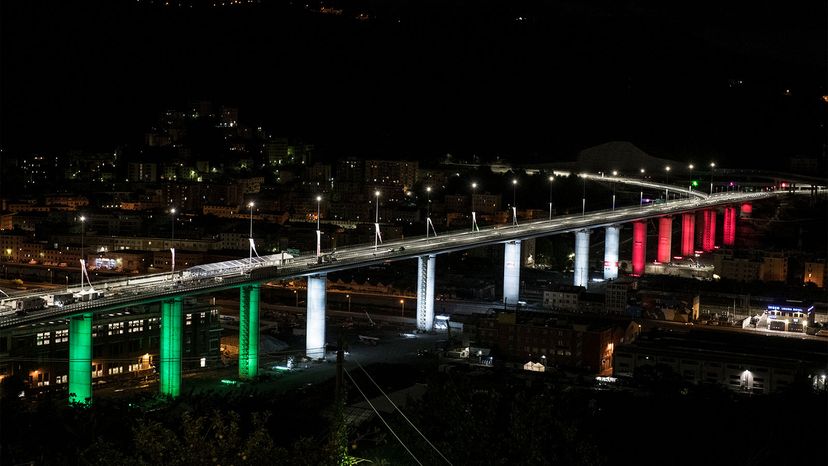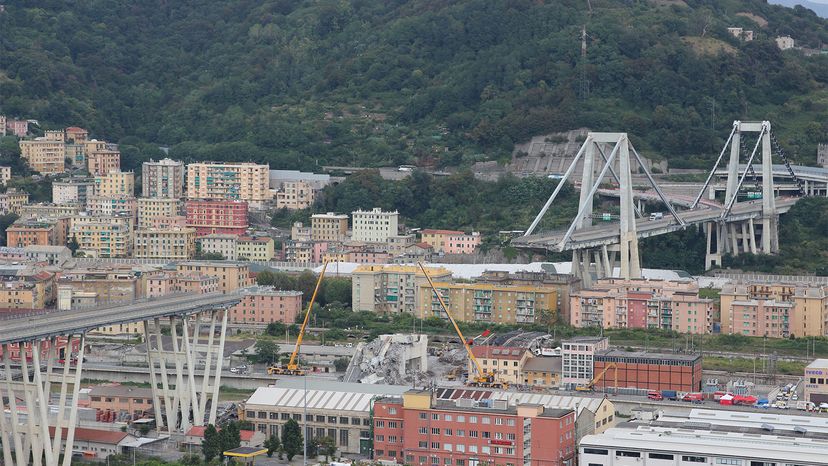Bridges of the Future

Since humans began to erect bridges in ancient times, the art and science of bridge design has evolved as architects, engineers and builders have developed new materials, design and construction techniques. Timber and stone were placed by concrete, iron, and eventually steel, and welding and bolts replaced rivets. Calculations and hand-drafted plans have been supplanted by computer-aided design. Such changes often have taken a long time to become standard, since big bridges aren’t built that often and can take years to complete [source: Lomax and Duffy].
Bridge-building is in the midst of yet another stage of evolution, thanks to advances ranging from sensing technology, which can collect data on how bridge structures perform in real time, to design innovations that are better able to handle stresses.
Advertisement

A 2021 article in MIT Technology Review highlighted several recently-erected bridges that incorporate new technologies. After Genoa’s Ponte Morandi bridge collapsed in a catastrophic accident in 2018 that killed 43 people, for example, it was replaced by Viadotto San Giorgio, a structure that incorporates a digital monitoring system and dehumidifying technology that’s intended to protect against corrosion, the cause of the previous disaster. Hong Kong’s Stonecutters Bridge utilizes a cable-stayed design with giant towers with stainless steel segments wrapped around ringlike concrete structures, and is built to withstand typhoon wind speeds of up to 212 miles per hour (341 kilometers per hour) [source: Allsop].
The use of sensing technology to monitor wear-and-tear on bridges is another important development. Wireless devices now can collect data on loads, deformation and vibration to which bridges are subjected, as well as spot the development of cracks smaller than the thickness of a dime in structural materials, so that they can be repaired before they become a safety threat [source: Reeve].
University of New Hampshire engineers have equipped an existing structure, the Memorial Bridge between Portsmouth, New Hampshire and Kittery, Maine, with sensors that have turned it what they call a "living bridge, " which continually reports upon its performance and also upon traffic patterns, weather conditions, and sea level and tides. The retrofit also includes a tidal turbine beneath the bridge, which they’ll use to study the potential for using bridges to generate renewable energy [source: University of New Hampshire].
Meanwhile, researchers are working to develop even more transformative innovations, such as new types of concrete and bridges that change shape to minimize wind resistance [source: Allsop].
Related Articles
- Everyday Science: Bridge Quiz
- Top 10 Structurally Amazing Bridges
- How Iron and Steel Work
- 10 Cool Engineering Tricks the Romans Taught Us
- 5 Heaviest Buildings Ever Moved
- How San Francisco's Golden Gate Bridge Was Built, and Why It's Not Actually Red
- Top 5 Ancient Incan Inventions
- Why do bridges ice before the rest of the highway?
More Great Links
Sources
- Allsop, Jon. "Five modern bridges that are pushing the bounds of engineering." MIT Technology Review. April 28, 2021. (Nov. 8, 2021) https://www.technologyreview.com/2021/04/28/1023041/modern-urban-city-bridge-technology-construction-genoa-stockholm-china-seattle/
- Blockley, David. "Bridges: The Science and Art of the World's Most Inspiring Structures." Oxford University Press. 2010. (Nov. 7, 2021) https://bit.ly/3BOikSN
- "Bridge Engineering." Arup. (Nov. 7, 2021) https://www.arup.com/expertise/services/infrastructure/bridge-engineering
- "Bridge Engineering." Britannica. (Nov. 7, 2021) https://www.britannica.com/technology/bridge-engineering/Truss
- "Build a Bridge." NOVA. October 2000. (Nov. 7, 2021) http://www.pbs.org/wgbh/nova/bridge/build.html
- Foer, Joshua. "The Last Incan Grass Bridge." Slate. Feb. 22, 2011. (Nov. 7, 2021) http://www.slate.com/id/2286002/
- Kennedy, Catherine. "Future of Bridges|Innovation versus risk." New Civil Engineer. Dec. 17, 2019. (Nov. 7, 2021) https://www.newciv ilengineer.com/the-future-of/future-of-bridges-innovation-versus-risk-17-12-2019/
- Lomax, Scott and Duffy, Thomas. "The New Technology of Bridge Design." Structure. Oct. 2013. (Nov. 8. 2021) https://www.structuremag.org/?p=760
- Merchant, Brian. "Living Bridges in India Have Grown for 500 Years." TreeHugger.com. Sept. 28, 2010. (Nov. 7, 2021) https://bit.ly/3bNhYkv
- Parameswaran, Lakshmy. "Recent Developments in Design and Construction of Concrete Road Bridges." Intra Construction & Equipment Magazine. 2021. (Nov. 7, 2021) https://www.nbmcw.com/article-report/infrastructure-construction/bridges/recent-developments-in-design-and-construction-of-concrete-road-bridges.html
- Reeve, Scott. "Smart Sensors Set to Monitor Bridge Structures in Real Time." Creative Composites Group. Aug. 29, 2018. (Nov. 8, 2021) https://www.creativecompositesgroup.com/blog/smart-sensors-set-to-monitor-bridge-structures-in-real-time
- "Rivers." Human Planet Explorer. 2011 (Nov. 7, 2021) https://www.bbc.co.uk/programmes/b00rrd7w
- "The Latest Steel Bridge Inn ovations." American Institute of Steel Construction. 2021. (Nov. 7, 2021) https://www.aisc.org/nsba/design-and-estimation-resourcesNoc/bridge-innovations/
- University of New Hampshire. "It's alive! Researchers create innovative 'living' bridge." Phys.org. June 4, 2019. (Nov. 8, 2021) https://phys.org/news/2019-06-alive-bridge.html
- Wilford, John Noble. "How the Inca Leapt Canyons." New York Times. May 8, 2007. (Nov. 7, 2021) http://www.nytimes.com/2007/05/08/science/08bridg.html